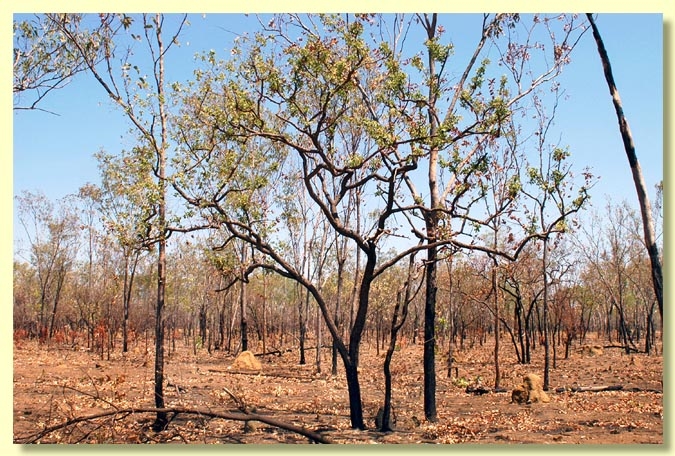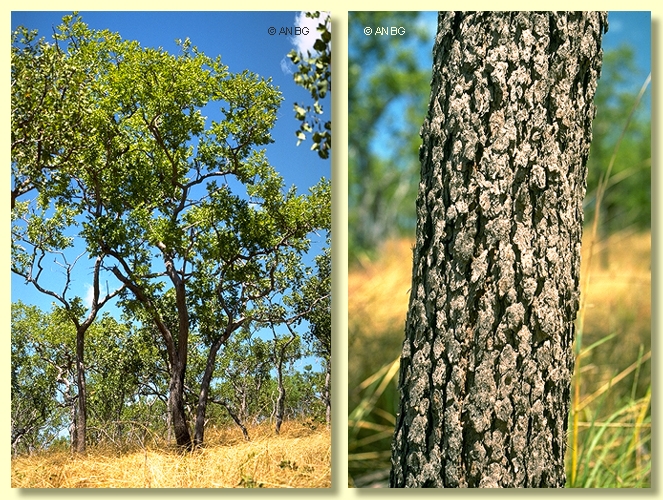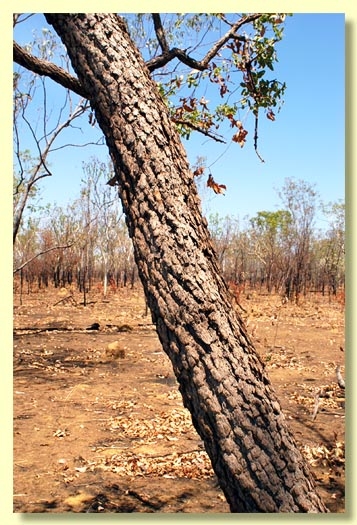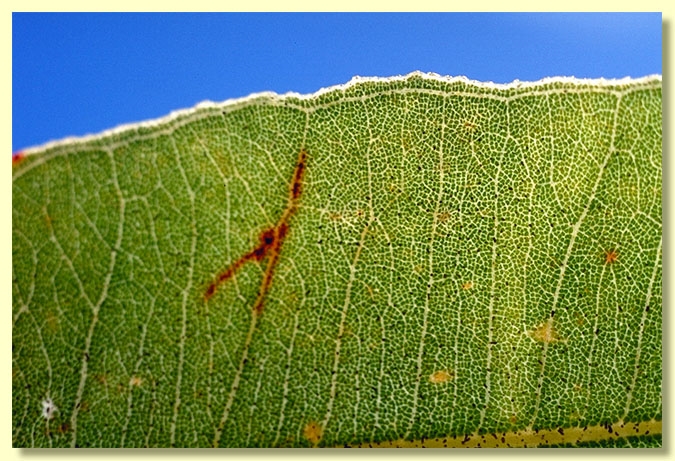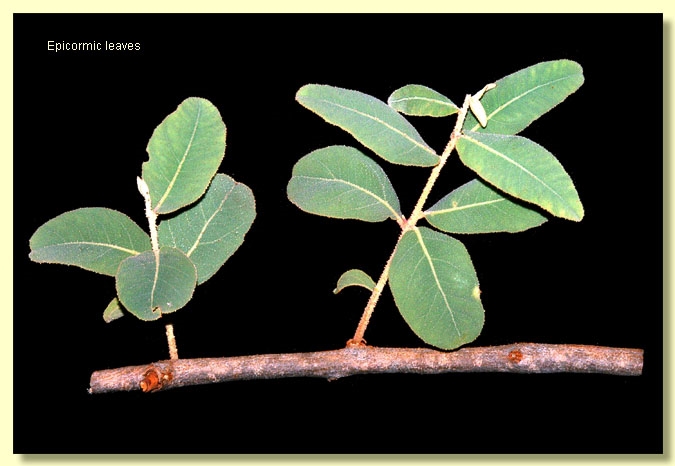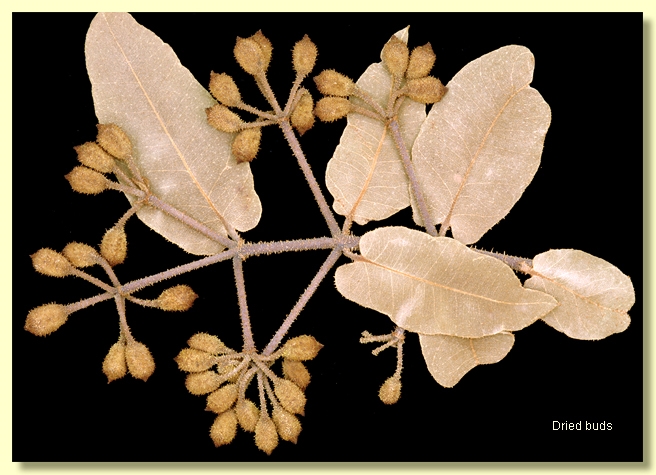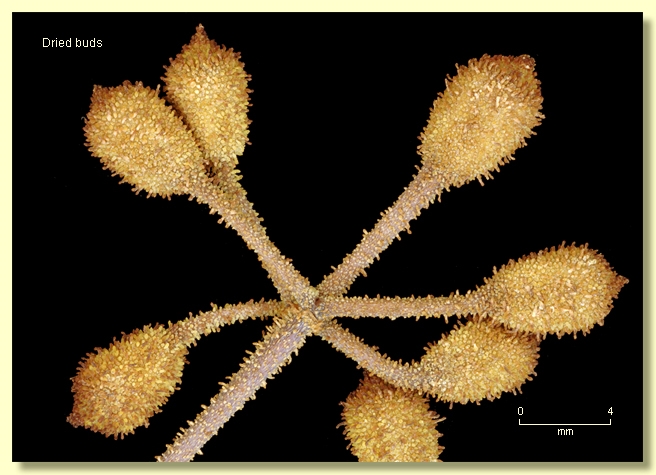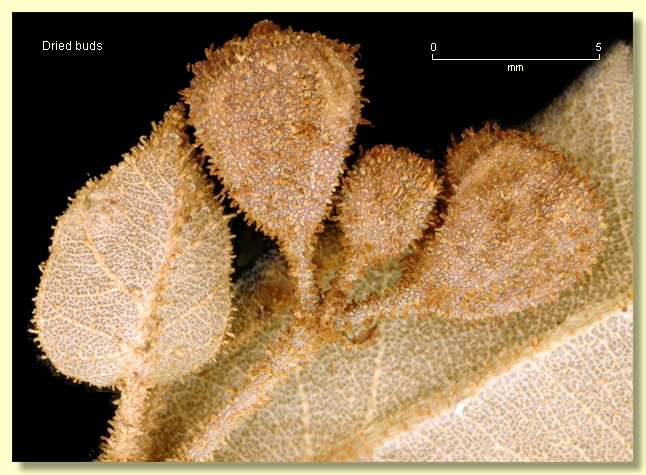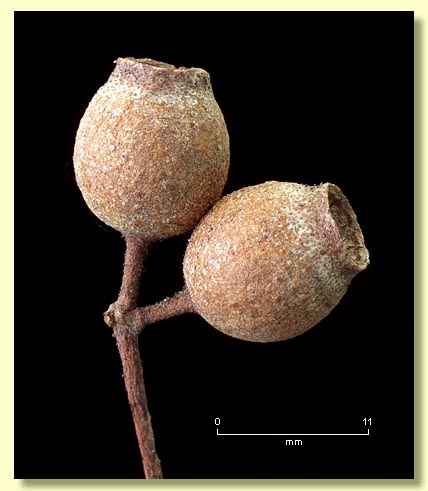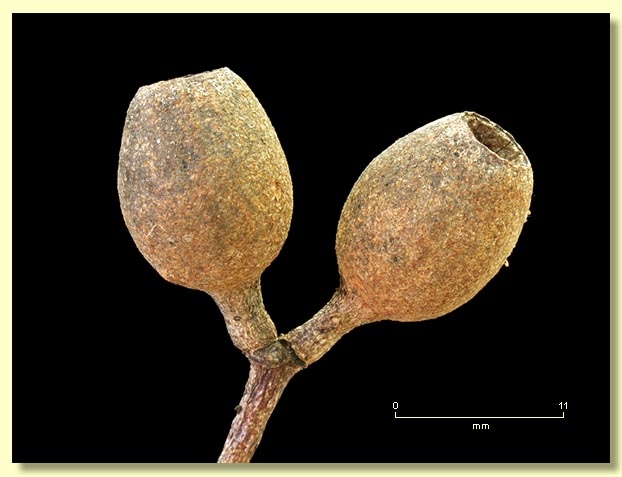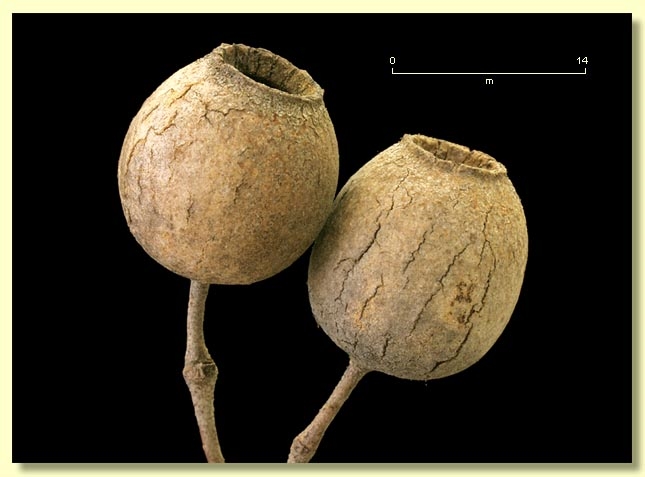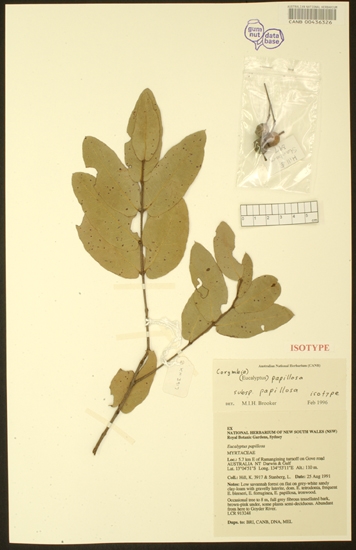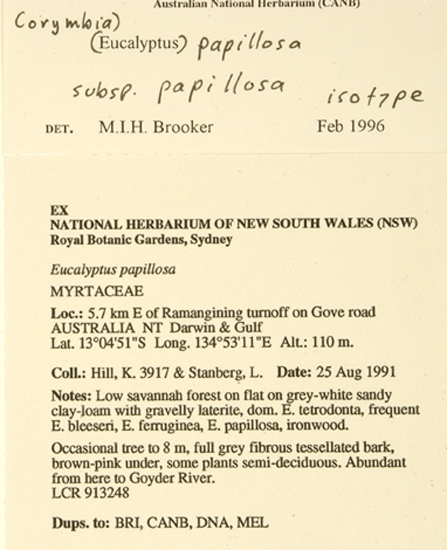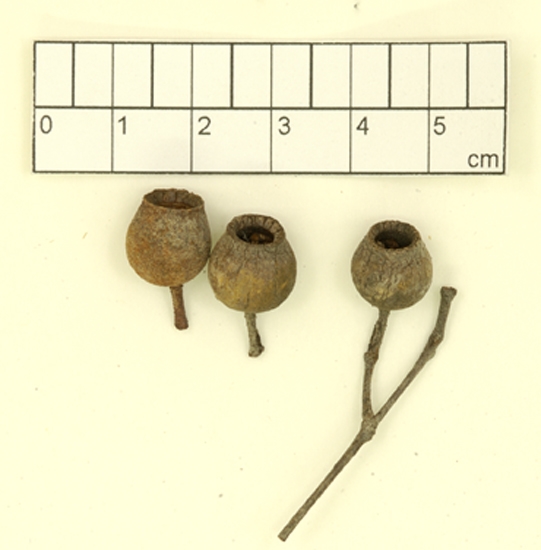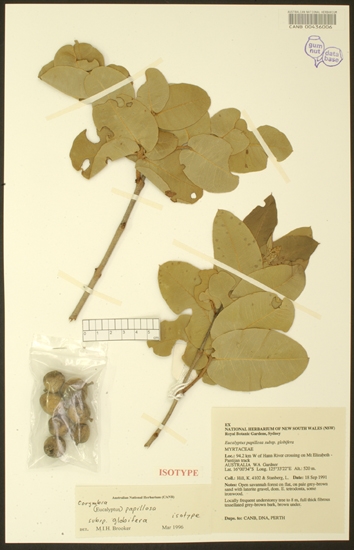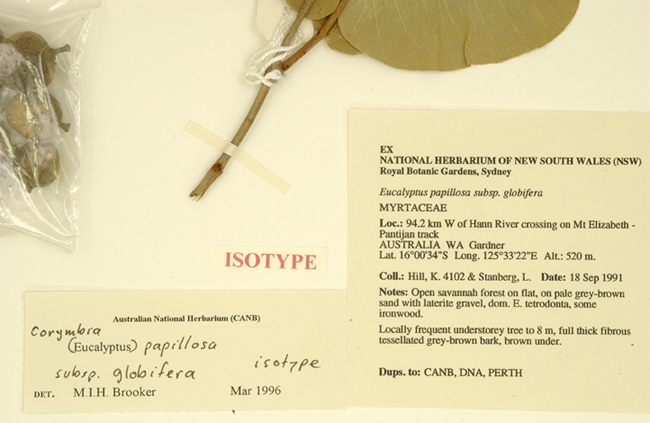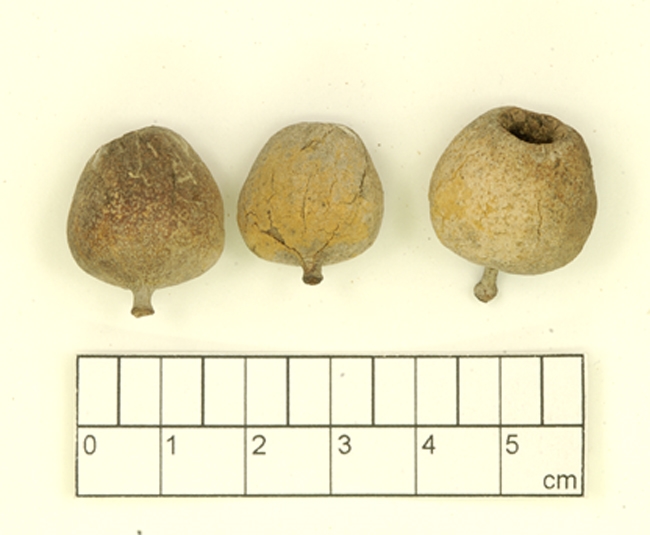Corymbia | Rufaria
Euclid - Online edition
Corymbia papillosa
Corymbia papillosa K.D.Hill & L.A.S.Johnson, Telopea 6: 362 (1995).
Tree 8 m tall. Forming a lignotuber.
Bark rough throughout, tessellated, flaking or scaly, thick, grey-brown over pinkish.
Branchlets setose or scabrid; non-glaucous; lack oil glands in the pith.
Juvenile growth (coppice or field seedlings to 50 cm): stems rounded in cross-section, scabrid; juvenile leaves opposite, sessile or subsessile, cordate to oblong, to 3–10 cm long, 1.5–5 cm wide, green, shortly setose/scabrid.
Crown of thin-textured juvenile leaves, opposite, sessile or with petioles to 0.8 cm long; blade oblong to elliptical, (3.5)4–12.2 cm long, 2–5.5 cm wide, base amplexicaul or lobed, margin entire, apex pointed or rounded and apiculate, concolorous, dull, yellow-green to light green to grey-green, scabrid with dense short setae more or less even in length, side-veins at a wide angle to the midrib (penniveined), reticulation very dense, intramarginal vein present, close to the margin, oil glands apparently absent from the venation pattern.
Inflorescence terminal compound and with some solitary clusters in upper axils, peduncles rounded or angled, 0.5–3 cm long, buds 7 per umbel, pedicels 0.1–0.9 cm. Mature buds pyriform to obovoid, ca 0.6 cm long, 0.4–0.5 cm wide, densely and evenly setose, scar absent (both opercula shed together at flowering), operculum conical or rounded, stamens inflexed, all fertile, anthers versatile, dorsifixed, oblong, dehiscing by longitudinal slits, style long and straight, stigma blunt and ? with a fringe of papillae, locules (3)4, with 5 or 7 vertical ovule rows, or the rows indistinct on the placentae. Flowers white.
Fruit pedicellate (pedicels 0.2–1 cm long), urceolate to barrel-shaped with a short neck, (1)1.2–1.7 cm long, (0.8)1–1.6 cm wide, relatively thin-walled, rim not prominent, surface rough or becoming smooth, disc descending vertically, valves (3)4, enclosed.
Seeds brown, 8–11 mm long, ellipsoidal with terminal wing, hilum ventral.
Cultivated seedlings (measured at ca node 10): not grown yet.
Flowering has been recorded in November.
A small stunted tree that occurs in the Top End of the Northern Territory from east of Port Keats north to Labelle Downs, more inland around El Sharana, and across the northern coastal plain from Narbarlek east to Caledon Bay. It also occurs disjunctly in the central Kimberley region of Western Australia where it is known with certainty from only two sites, the Caroline Ranges west of Mount Elizabeth station and north of Drysdale River crossing on the Kalumburu road on Doongan Station. It is found in a variety of habitats, from deep sandy loams to gravelly or sandy sites on gentle slopes, and in the north-east of the range, on seasonally swampy ground. Corymbia papillosa has thick rough tessellated to fissured bark extending to the small branches, a crown of opposite, thin-textured, setose or scabrid, ± sessile leaves, small shortly setose buds and small rough to smooth, barrel-shaped to globose fruit. It occurs as an understory tree in taller Eucalyptus tetrodonta woodland or as stunted tree in lower more open woodland.
C. papillosa is one of a group of northern bloodwood species conspicuous because they have opposite ± sessile leaves making up the crown and in most cases have setae on the young branchlets, the leaves and buds, and on coppice growth. Within its natural range C. papillosa is most similar to C. dunlopiana, but that species differs in having prominently beaked buds on longer pedicels, red flowers and larger fruit (more than 2.2 cm wide). In the north of its distribution C. papillosa is likely to be found growing near C. chartacea, but the latter has papery, large glabrous leaves, prominently beaked buds, fruit > 2 cm wide and conspicuously drooping branchlets. Of the other species in this opposite-leaved group only C. deserticola has fruit as small as C. papillosa. It also has shorter leaves that are slightly scabrid to smooth, not obviously setose as in C. papillosa, and as the name suggests, C. deserticola has an arid distribution, extending through the Tanami and Gibson Deserts to the Pilbara region.
C. papillosa was formerly included in C. setosa, but the latter is now regarded as occurring from Tennant Creek and Daly Waters through the Gulf of Carpentaria hinterland east to Barcaldine and south-eastern Cape York Peninsula around Musgrave in Queensland. C. setosa differs in having larger fruit 1.3–2.5 cm wide and grey-green crown leaves more ovate and smaller than in C. papillosa, but with some overlap in dimensions.
Hill & Johnson (1995) described two subspecies of C. papillosa (subsp. papillosa and subsp. globifera) based on fruit size and shape and pedicel length, prompted no doubt by the geographic disjunction in the distribution. The few Kimberley specimens seen in the herbarium and the field certainly do have slightly larger fruit than those from the Northern Territory but with some overlap in dimensions; however, the pedicel lengths are variable in both areas showing almost complete overlap. Fruit shape varies from barrel-shaped to ± globular across the Northern Territory populations, whilst the Kimberley material seen suggests they are predominantly globular. Therefore in EUCLID Corymbia papillosa subsp. globifera is placed in synonymy.
MORE ABOUT CORYMBIA
MORE ABOUT RED BLOODWOODS
Corymbia papillosa: Latin papilla, a nipple and –osus, many, referring to the microscopic short trichomes or hairs that adorn the bristle-glands.

